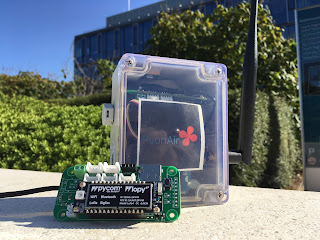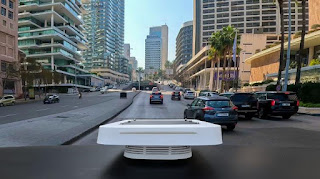Leveraging Open Source Hardware Solutions for Clean & Quality Air in Ghana
- November 16, 2023
- 8 min read
Growing up in Accra, Ghana, my daily routine involved waking up at an ungodly hour to try and catch a bus to my local high school. Each morning, my father would rouse me from my slumber as early as 4 am to ensure I beat the infamous Accra morning traffic. On one particular day, I vividly recall arriving at my bus stop around 6:30 am to 7:00 am. There, I encountered a local Ga woman, who, inexplicably, was openly burning waste by the roadside on the path to my school.
As a young teenager, dressed neatly and eager to make a positive impression on my high school peers, I was distressed by the prospect of smelling like burnt waste so early in the morning. I found myself wondering, “Why is she burning waste right here, so close to the road, and at such an early hour?” In hindsight, the more appropriate question should have been, “Why does she need to burn waste at all?” Unfortunately, this story is just one of countless experiences that many Ghanaians share when it comes to air pollution in Accra. It is a distressingly common activity in our daily lives.

Air pollution is the second leading cause of health problems in Ghana, resulting in a staggering 28,000 premature deaths each year, according to the World Health Organization’s 2020 data.
The main culprits for poor air quality in Ghana include cooking with wood and charcoal, road transportation, slash-and-burn farming techniques, open waste burning, energy generation, accidental fires, and industrial processes. While deaths due to household air pollution have decreased since 1997, fatalities resulting from outdoor air pollution have risen. (Clean Air Fund)

Photo credit (citinewsroom)
As Ghana’s various regions continue to rapidly urbanize, it is evident that the air pollution issue will only intensify. Therefore, it is imperative that we develop strategies to monitor and combat air pollution in Ghana. Open source hardware offers a promising avenue for both monitoring air quality in Ghana and creating solutions to address this pressing environmental crisis.
Open source hardware is hardware whose design is made publicly available so that anyone can study, modify, distribute, make, and sell the design or hardware based on that design. The hardware’s source, the design from which it is made, is available in the preferred format for making modifications to it. Ideally, open source hardware uses readily-available components and materials, standard processes, open infrastructure, unrestricted content, and open-source design tools to maximize the ability of individuals to make and use hardware. (Open Source Hardware Association)
In recent times, there has been a shift from proprietary technologies to free and open source solutions. By making hardware solutions open source and accessible to all, we promote widespread participation. Air pollution is a significant challenge in Ghana, making the widespread adoption of open source solutions for clean air an imperative.
Here are some key advantages of using open source hardware solutions for addressing air quality issues in Ghana:
– Transparency: Open source hardware provides a clear understanding of how a system works, enabling easy replication and customization. Making hardware designs, code, and collected data accessible to everyone advances air quality monitoring.
– Collaboration: Open source hardware fosters a community of users and developers who engage in constructive discussions, enhancing innovation and improvement. Africa Open Science & Hardware (AfricaOSH), Gathering for Open Science Hardware (GOSH), the Open Source Hardware Association (OSHWA) are all examples of communities of users and developers who engage in open science/source hardware discussions.
– Cost-effective: Without licensing costs, users and developers need only purchase the necessary hardware tools and freely available software to begin creating open source hardware solutions for clean air. A paper by Joshua Pearce states that, “…open source technologies provide economic savings of 87% compared to equivalent or lesser proprietary tools. These economic savings increased slightly to 89% for those that used Arduino technology and even more to 92% for those that used RepRap-class 3-D printing. Combining both Arduino and 3-D printing the savings averaged 94% for free and open source tools over commercial equivalents. The results provide strong evidence for financial support of open source hardware and software development for the sciences. Given the overwhelming economic advantages of free and open source technologies, it appears financially responsible to divert funding of proprietary scientific tools and their development in favor of free and open source hardware”.
– Accessibility: The easy accessibility of open source hardware solutions makes them scalable and implementable on a large scale. Solutions for monitoring and improving air quality can be deployed widely to enhance their effectiveness.
An increase in sensor technologies has enabled measurement of levels of pollution in urban areas, providing concrete data that can be used to reinforce the need for policy change towards heavily-polluting procedures. Many of these technologies are, however, closed-source and monetised. (Fablabbcn)
Embracing open source hardware solutions for clean air empowers community groups and individuals across Ghana to measure local air pollution, identify its sources, and collaborate with local officials and stakeholders to improve air quality. Collecting vital data on air quality in Ghana and the causes of air pollution can inform much-needed policy changes in a country experiencing rapid urbanization and industrialization.
Some open source hardware solutions for clean air include:
PyonAir – an Open Source Air Pollution Monitor – The PyonAir is a low-cost system for monitoring local air pollution levels – specifically, particulate matter. Based around the Pycom LoPy4 board and Grove-compatible hardware, the system can transmit data over both LoRa and WiFi.

Photo credit (PyonAir)
The aim of the PyonAir project is to deploy a network of low-cost, IoT pollution monitors that will allow anyone to gather crucial information about the distribution and causes of air pollution. Whilst there are many pollution monitors on the market, most only offer “Air Quality Index”, rather than raw PM data , especially at affordable prices. By making the project open-source, with easy setup instructions, the hope is to make the PyonAir device accessible to anyone who is interested in air quality, either personally or professionally. For example, this device can be used to collect data for student projects, PhDs and independent parties, making vital research that has a reputation for soaring costs much more attainable. The project may also be used for outreach purposes, communicating with members of the public about their local air quality and the steps that can be taken to improve it.
Flatburn, The Mobile Air Pollution Scanner – Researchers at MIT have created an open-source version of a low-cost, mobile pollution detector that could enable people to easily track air quality. The detector, called Flatburn, is part of a larger project, known as City Scanner, using mobile devices to better understand urban life.

Photo credit (MIT)
Flatburn can be made by 3D printing or by ordering inexpensive parts. The detector has been tested and calibrated in relation to existing state-of-the-art machines, and complete details about its construction, use, and data interpretation have been publicly released.
FieldKit Air Quality – FieldKit is an easy to use , low cost hardware for environmental sensing. FieldKit stations are built to be easily deployed, and their mobile app makes configuration and maintenance simple. The FieldKit platform lets you quickly and easily visualize station data, discover trends and patterns, and share your findings with anyone. It makes it easy to download your data in a variety of useful formats, so that FieldKit can play nicely with your existing tools. FieldKit is dedicated to supporting a strong community of users and developers, building both local and global connections. On the FieldKit community forum, you can engage in discussions with scientists, educators, tech experts and curious individuals – all working to better understand and advocate for the world around them.

Photo Credit (FieldKit)
FieldKit is currently working on bringing FieldKit Air Quality to market.
I envision a future where Ghanaians utilize open source hardware solutions to monitor air quality and address air pollution’s root causes. By leveraging the recorded data, we can influence policy and regulations to promote environmental sustainability. In the words of Desmond Appiah, Head of Clean Air Fund in Ghana, “Addressing air pollution presents a real opportunity to tackle the unique impacts of the climate crisis in Africa and to support an informed path to sustainable development for the continent.”
Resources:
https://www.instructables.com/PyonAir-an-Open-Source-Air-Pollution-Monitor/
https://www.wevolver.com/article/open-source-projects-for-improving-air-and-water-quality
https://news.mit.edu/2023/low-cost-device-can-measure-air-pollution-anywhere-0316
https://fablabbcn.org/blog/make-things/open-source-sensor-tools-to-measure-air-pollution
https://www.cleanairfund.org/geography/ghana/
https://github.com/MIT-Senseable-City-Lab/OSCS
https://www.sciencedirect.com/science/article/pii/S2468067220300481
Cover photo credits: claudi rodrigues
















